<< Previous | Displaying results 6001-6050 of 6709 for "" | Next >>
-
American athletes Jesse Owens and Dave Albritton
PhotoAfrican American athletes Jesse Owens and Dave Albritton pose with a German citizen. They both competed in the 1936 Olympic Games. Albritton won the silver medal in high jump. Owens won gold medals in the 100-meter dash, 200-meter dash, broad (long) jump, and the 4x100-meter relay.
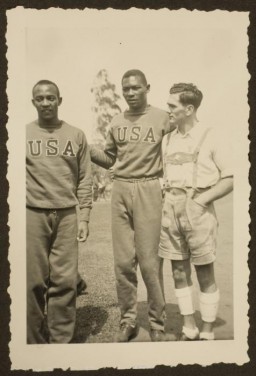
-
Archie Williams at the 1936 Olympic Games in Berlin
PhotoAfrican American athlete Archie Williams competed in the 1936 Berlin Olympic Games. He won the gold medal in the 400-meter race. The US team was the second largest to compete in the 1936 Summer Olympic Games with 312 members, including 18 African Americans.
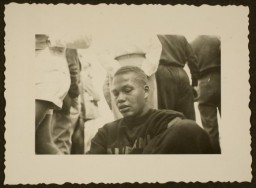
-
Portrait of Janusz Korczak
PhotoPortrait of Janusz Korczak, a Polish Jewish doctor and author who ran a Jewish orphanage in Warsaw, circa 1930.
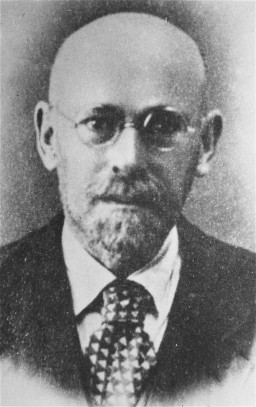
-
Sculpture memorializing Janusz Korczak
PhotoA wall sculpture memorializing Polish Jewish doctor Janusz Korczak resides on the exterior of a teaching hospital that bears his name, Olsztyn, Poland.
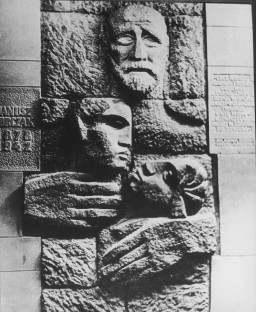
-
The Krochmalna Street Orphanage
PhotoExterior view of the Jewish orphanage run by Janusz Korczak. Established in 1912, the orphanage was located at 92 Krochmalna Street in Warsaw, Poland. Photo taken circa 1935.
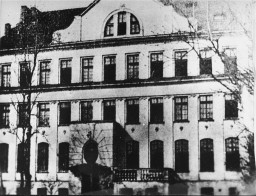
-
Nazi propaganda depicting German children
PhotoIn this Nazi propaganda picture, young German children are shown eating a meal. The original caption reads: "Everything for the healthy child." Photo dated 1933–1943.
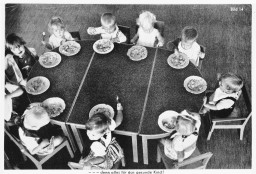
-
Lebensborn program home
PhotoTwo photos showing the exterior and interior views of a Lebensborn home, circa 1933–1943.

-
Two of the "Tehran Children"
PhotoPhotograph of two of the Tehran Children, who reached Palestine in 1943 via Iran.

-
SS troops stand at attention
PhotoSS troops stand at attention for inspection, Germany, 1936-1939. This photo is from an album of SS photographs.

-
German police deployment during World War II
PhotoPropaganda poster depicting two Germans in the field during World War II. After the war began in 1939, Police Battalions were deployed alongside the German military. This poster was designed by SS-Hauptsturmführer Felix Albrecht in 1941.

-
German Order Policeman in occupied Lodz
PhotoBernhardt Colberg, a member of Reserve Police Battalion 101, poses in front of its headquarters in the vicinity of Lodz in German-occupied Poland. The police battalions were units of the German Order Police who were deployed to German-occupied areas of Europe during World War II. Photo dated 1940–1941.
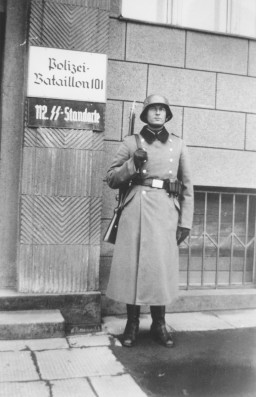
-
German Order Policemen publicly humiliate Jews
PhotoMembers of the German Order Police publicly humiliate a group of Jews by forcing them to perform exercises, 1939–1940. Sosnowiec, in German-occupied Poland.

-
German Order Policemen stand guard over a group of Jewish men
PhotoMembers of the German Order Police stand guard over a group of Orthodox Jewish men, 1942. The men have been rounded-up either for forced labor or public humiliation. Krakow, in German-occupied Poland.

-
German Order Police during the expulsion of Jews from Sieradz
PhotoA member of the German Order Police raises a stick to beat a Jew who is loading his bundles onto a wagon during expulsion from the community of Sieradz in German-occupied Poland. Photo dated 1940–1942.
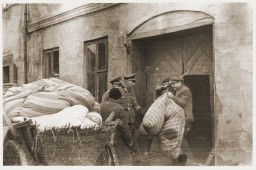
-
German police search a Jewish man at gunpoint
PhotoGerman policemen search an elderly, religious Jew at gunpoint in German-occupied Poland, circa 1941.
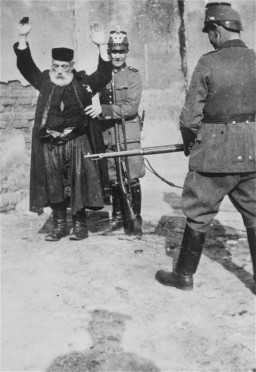
-
Order Police Battalion 101
PhotoGerman Order Police officers inspect members of Police Battalion 101 in Lodz after the German occupation of Poland, 1939–1943.
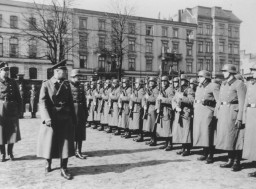
-
Prewar photo of the extended Kracowski family
PhotoThe Kracowski family was living in Bialystok when German Order Police Battalion 309 killed 2,000-3,000 Jews on June 27, 1941. Dr. Samuel Kracowski was among the hundreds of Jews locked in the Great Synagogue and burned alive. After the Germans ordered the establishment of a ghetto in Bialystok, Samuel's wife, Esther, and children, Ewa and Julek, were given a room in the ghetto clinic. Photo dated September 1, 1935. Samuel and Esther are seated in the center, with Julek seated in the front row on the…

-
German Order Police Battalion 101
PhotoA member of the German Order Police Battalion 101 stands next to a sign marking the entrance to the Lodz ghetto in German-occupied Poland, 1940–1941. The German text of the sign reads: "Announcement: In accordance with a police order of February 8, 1940, all Germans and Poles are forbidden entry into the ghetto area."

-
Manzanar
PhotoManzanar relocation center for Japanese Americans, photographed by Ansel Adams. Bird's-eye view of the grounds from the guard tower.

-
Refugee camp in Zbaszyn
PhotoView of Zbaszyn, the site of a refugee camp for Jews of Polish nationality who were expelled from Germany. The Jewish refugees, hungry and cold, were stranded on the border, denied admission into Poland after their expulsion from Germany. Photograph taken between October 28, 1938, and August 1939. Warsaw-based historian, political activist, and social welfare worker Emanuel Ringelblum spent five weeks in Zbaszyn, organizing assistance for the refugees trapped on the border.
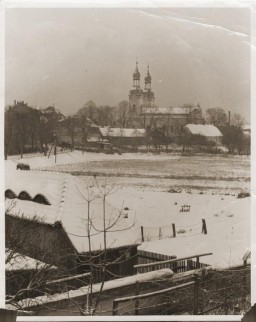
-
View of the refugee camp in Zbaszyn
PhotoView of the flour mill in Zbaszyn, which served as a refugee camp for Jews expelled from Germany. The Jewish refugees, hungry and cold, were stranded on the border, denied admission into Poland after their explusion from Germany. Photograph taken between October 28, 1938, and August 1939. Warsaw-based historian, political activist, and social welfare worker Emanuel Ringelblum spent five weeks in Zbaszyn, organizing assistance for the refugees trapped on the border.

-
Group portrait of Jews expelled to Zbaszyn
PhotoNovember 1938 group portrait of Jews of Polish nationality who were expelled from Nuremberg, Germany, to the Polish border town of Zbaszyn. The Jewish refugees were stranded on the border and were denied admission into Poland after their explusion from Germany.Pictured from left to right are: Leo Fallmann; Rosa Fallmann; Mr. Auerbach; Mr. Zahn; unknown; unknown; Chaim Kupfermann; Anni Kupfermann; Simon Wassermann; unknown; Regina Holzer; and Bertha Holzer.
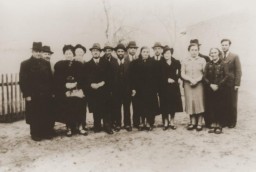
-
Theo Markus Verderber
PhotoTheo Markus Verderber's mother, Gelle, was among the Jews of Polish nationality expelled from Germany in October 1938. Theo and his younger brother were born in Germany, but went with their mother to a refugee camp in the border town of Zbaszyn. Hungry and cold, the refugees were stranded on the border, unwelcome in either Germany or Poland. Theo was ultimately chosen to join a Kindertransport to England, arriving there in February 1939. His mother, sister and youngest brother remained in…
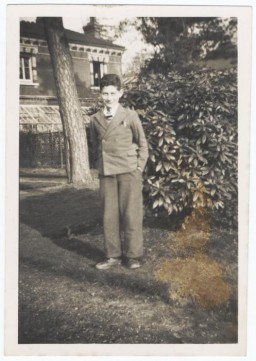
-
Arrival at Auschwitz
PhotoJews from Subcarpathian Rus get off the deportation train and assemble on the ramp at the Auschwitz-Birkenau killing center in occupied Poland. May 1944.

-
Signing of the German-Soviet Pact
PhotoSoviet Foreign Minister Molotov signs the German-Soviet Pact. Joachim von Ribbentrop and Josef Stalin stand behind him, Moscow, Soviet Union, August 23. 1939.
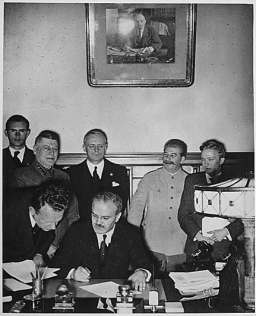
-
Forced labor at a Siemens factory
PhotoPrisoners at forced labor building airplane parts at the Siemens factory in the Bobrek labor camp, a subcamp of Auschwitz. February-June 1944. David Stein is pictured in the row to the right, with his back to the camera; his brother Charles is in the same row, fourth from the left, facing the camera.

-
View of the Wannsee Villa
PhotoOn January 20, 1942, the villa was the site of the Wannsee Conference.

-
Group portrait of Jewish friends in Hungary
PhotoGroup portrait of Jewish friends at a swimming pool in Kalocsa, Hungary, 1930.
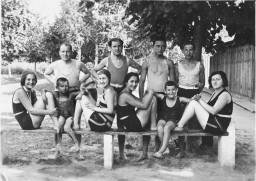
-
Rohingya in a refugee camp
PhotoRohingya walk into a section of the Balukhali refugee camp in Bangladesh, September 2017.

-
Soldiers swear an oath of loyalty to Hitler
PhotoIn Poznan, ethnic German recruits to the German army swear allegiance to Adolf Hitler. January 1940.
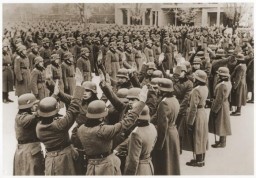
-
Military troops taken oath of loyalty
PhotoTroops take the oath of obedience to Adolf Hitler. Germany, January 1939.
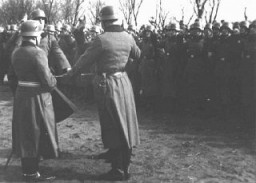
-
Poster for Nazi Party speech on Jewish Bolshevik threat
PhotoPoster for a meeting and speech about the Jewish Bolshevik threat against Germany sponsored by the local Nazi Party of East Hannover. Depicted is a silhouetted caricature of a Jewish man’s head in left profile, with a large, red Star of David beside him. The announcement at the top of the poster reads: "Victory over Bolshevism and plutocracy means being freed from the Jewish parasite!" Created ca. 1937–1940.
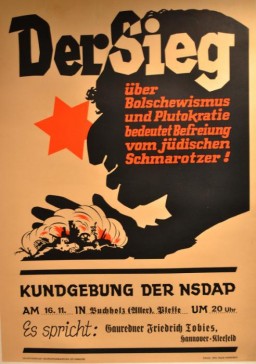
-
Disembarking from the St. Louis in Amsterdam
PhotoA Jewish refugee couple poses on the gangway of the MS St. Louis as they disembark from the ship in Antwerp. Belgium, June 17, 1939.
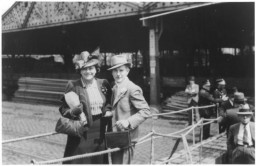
-
Yevgeny Khaldei views the destruction of Budapest
PhotoSoviet photographer Yevgeny Khaldei views the destruction of Budapest from a rooftop. Budapest, Hungary, February 1945.
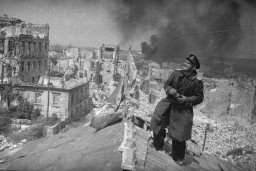
-
Yevgeny Khaldei standing on top of the Brandenburg Gate
PhotoSoviet photographer Yevgeny Khaldei stands on top of the Brandenburg Gate in Berlin where he, along with a few Soviet soldiers, raised the Soviet flag. Berlin, Germany, May 1945.

-
Unit of Soviet soldiers
PhotoA unit of Soviet soldiers walks along a narrow strip of land that juts into the water while on a reconnaissance mission in Murmansk. Photograph taken by Soviet photographer Yevgeny Khaldei. Murmansk, Soviet Union, 1941.

-
Soviet planes fly over Berlin
PhotoSoviet planes fly over the destroyed Reichstag (German parliament) building in Berlin. Photograph taken by Yevgeny Khaldei. Berlin, Germany, ca. April 1945.

-
A Soviet soldier amidst destruction in Budapest
PhotoPortrait of a Soviet soldier standing on a heavily damaged street in Budapest. Photograph taken by Soviet photographer Yevgeny Khaldei. The location is Apponyi Square. On either side of the street are the ruins of the Clotild Palaces. In the background is the Erzsebet (Elizabeth) bridge. Budapest, Hungary, 1945.
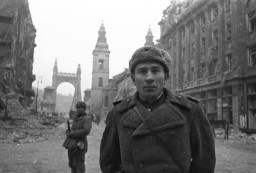
-
Soviet tanks in Vienna
PhotoSoviet tanks roll down a street in Vienna during the Soviet conquest of the Austrian capital at the end of World War II. Photograph taken by Yevgeny Khaldei. Vienna, Austria, 1945.
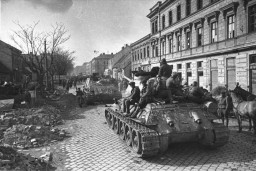
-
Two men standing in a doorway in the former Budapest ghetto
PhotoPortrait of two men standing in a doorway in the former Budapest ghetto, one of whom is wearing a painted yellow star on his jacket. Photograph taken by Yevgeny Khaldei. Budapest, Hungary, 1945.

-
Scene in the destroyed city of Murmansk
PhotoA woman walks along a road past a line of chimneys in the destroyed city of Murmansk. Photograph taken by Soviet photographer Yevgeny Khaldei. Murmansk, Soviet Union, 1942.
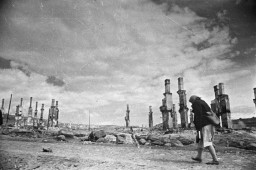
-
Soviet troops trample a Nazi flag
PhotoSoviet troops trample a Nazi flag as they march past a burning house on a street in the outskirts of Vienna. Photograph taken by Soviet photographer Yevgeny Khaldei. Vienna, Austria, April 1945.

-
Telegram from Quanza Passengers to Eleanor Roosevelt
PhotoThe SS Quanza was a Portuguese ship chartered by Jewish refugees attempting to escape Nazi-dominated Europe in August 1940. Passengers with valid visas were allowed to disembark in New York and Vera Cruz, but that left 81 refugees seeking asylum. On September 10, 1940, they sent this telegram to First Lady Eleanor Roosevelt to implore her for help.
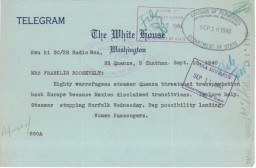
-
Card from SS Quanza Passengers to the White House
PhotoRefugee passengers of the SS Quanza sent a large bouquet of red roses and this message to First Lady Eleanor Roosevelt to thank her for her help. The First Lady made sure President Roosevelt saw both the flowers and the card, which were displayed prominently outside his bedroom.
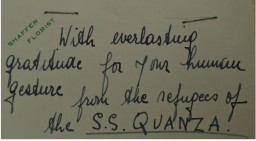
-
Passengers on the SS Quanza
PhotoPassengers on the SS Quanza while temporarily docked in Norfolk, Virginia. The Quanza was a Portuguese ship chartered by 317 Jewish refugees attempting to escape Nazi-dominated Europe in August 1940. Photo dated September 10, 1940.

-
Nazi eugenics poster
PhotoNazi eugenics poster entitled "Feeble-mindedness in related families in four neighboring towns." This poster shows how "feeble-mindedness" and alcoholism are passed down from one couple to their four children and their families. The poster was part of a series entitled, "Erblehre und Rassenkunde" (Theory of Inheritance and Racial Hygiene), published by the Verlag für nationale Literatur (Publisher for National Literature), Stuttgart, Germany, ca. 1935.
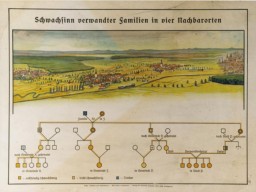
-
Propaganda slide showing the opportunity cost of feeding a person with a hereditary disease.
PhotoPropaganda slide produced by the Reich Propaganda Office showing the opportunity cost of feeding a person with a hereditary disease. The illustration shows that an entire family of healthy Germans can live for one day on the same 5.50 Reichsmarks it costs to support one ill person for the same amount of time. Dated 1936. Nazis defined individuals with mental, physical, or social disabilities as “hereditarily ill” and claimed such individuals placed both a genetic and financial burden upon society…
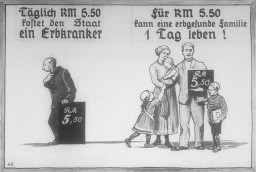
-
Scene in a camp for people displaced from Srebrenica
PhotoIn July 1995, Bosnian Serb forces killed as many as 8,000 Bosniaks from Srebrenica. It was the largest massacre in Europe since the Holocaust. This photograph shows a Bosniak woman at a makeshift camp for people displaced from Srebrenica in July 1995.
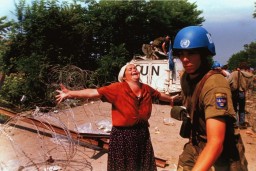
-
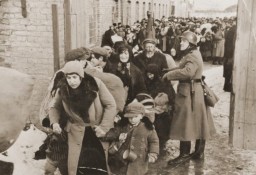
-
View of a burial site in Nyanza, Rwanda
PhotoNyanza is a site near Kigali, Rwanda, where several thousand people were executed after being marched from the Belgian Technical School in April 1994. At the school, they had been under the protection of UN peacekeepers until the soldiers were recalled to the airport to help evacuate expatriates. This is one of the few sites where victims had the honor of individual burial; most often they were buried together in large graves. Photograph taken on November 24, 2007. United States Holocaust Memorial Museum

